Every year at the end of the summer the Office Depot and Staples commercials seem endless while millions of children of all different age groups embark on a new year of school. Parents and kids are convinced every year to buy the newest and trendiest school supplies resulting in parents spending an average of 100 dollars on each child. Many times, parents buy more than their kids need, or buy materials they already have for the purpose of having something ‘new.’ We often think of how much money is wasted in these situations, but what about the amount of materials wasted? What is the impact that wasteful and careless spending on school supplies has on our planet?
The two materials that most school supplies contain are plastic and paper. Here at Malden High School, typically students will buy a notebook or binder full of loose leaf paper for each class. According to Ecology.com, each person in America uses roughly 700 pounds of paper each year. Let’s face it: most of us buy way more paper than we need. When you are standing there in the office supplies store in front of towering stacks of college ruled paper and spiral notebooks, your first thought may be to buy as much paper as you can so that you don’t have to worry about it later, but later you’ll have more paper than you need. Many people throw this away or forget about it, and buy more paper next year in the fall.
On the other hand, if you use a lot of paper and find yourself running out quickly, then maybe it’s time to start using the back of the paper or to take your work to your Google Docs (if possible). As reported by Ecology.com, nearly 4 billion trees are cut down every year just for making paper, but we could decrease this number by recycling and buying recycled paper and notebooks.
What a lot of people don’t realize is that cutting down trees and not recycling paper isn’t the only threat paper has on the environment. According to the Worldwatch Institute, pollutants like toluene, methanol, chlorine dioxide, and hydrochloric acid are emitted into the air and water from papermaking plants. Many of these chemicals take an effect on the organisms and ecosystems nearby, and can be harmful to humans.
Like paper, plastic has also become a material students are dependent on whether they are aware of it or not. If you walk around MHS, like any other high school, you will see multiple students carrying around a plastic Nalgene or Camelback waterbottle. Despite common belief, plastic reusable water bottles aren’t as environmentally sustainable as we think they are. Many people end up having to throw their water bottles away and buy a new one as the school year goes on if it breaks or if bacteria and dirt get trapped in the mouth pieces of the bottle. Buying a stainless steel bottle will prevent you from buying extra plastic. If we all showed water bottle companies that we want less plastic produced and more steel and glass, we could make a difference and reduce the amount of plastic produced and thrown away.
If you take lunch to school, chances are you most likely have some variation of tupperware, aluminum paper, and plastic wrap/sandwich bags. On top of that, you most likely buy at least one pack of pens, possibly one or a few spiral notebooks with a plastic cover, and many more supplies that contain/are made of plastic. It all adds up and we don’t even realize it. By reusing materials like lunch bags, pens, pencil cases, binders, notebooks, etc. you could reduce your yearly consumption of plastic products tremendously. The less plastic school related items you buy the less plastic gets made, processed in factories, transported, and thrown away.
Driving to and from school may seem like a harmless task, but carbon dioxide emissions from your car is increasing your carbon footprint, the amount of carbon dioxide and carbon compounds that are emitted into the atmosphere due to your consumption of fossil fuels. Most kids in middle school and high school are able to walk home and/or to school. If you are a student you can ask permission from your parents to walk or bike to school, or you could take public transportation. If you are not able to walk to school or don’t have a bike, taking the MBTA bus to school reduces the amount of individuals driving/being driven to school everyday.
As a last resort depending on if you’re willing, buying a portion or all of your clothes from thrift shops makes a huge difference on your carbon imprint. A lot of clothing materials like polyester, nylon, acrylic, cottons finished with formaldehyde, etc. are all made from petroleum oil. By decreasing the amount of new clothes you buy and by donating your old clothes to thrift shops, you will reduce the amount of petroleum used to make these products, the electricity and oil that is used to run clothing factories, the transporting of clothes from factories to stores, etc.
A common thought that most people have is that they will not be able to help the environment or make a difference by reducing their use of consumable products because they are just one individual out of 7 billion. What people don’t realize is that cutting back or reusing one thing in their life is just a start, and that if they have perseverance through the journey of living a more sustainable lifestyle, they will eventually reduce the use of more and more products that are harmful for the environment. Your actions could influence your friends and family to take similar actions as long as you are vocal about environmental justice, and you can show the people around you how much they consume and produce waste. Many people think that living more sustainably will cost them more, but buying the amount of things we actually need and not buying extra products that we don’t really need.
Reducing the amount of school supplies you buy every year may be hard, but it will make you more aware of how much you waste and how much money you could save by reusing. School is expensive for everyone at any age, so reducing the cost even by a little bit is always a good thing to do and will make you feel better. Remember that there are only positive consequences for reusing, reducing, and recycling.




